Photographing Tropical Forest Birds

ARTICLES
TROPICAL
BIRDS
By Laura L Fellows
Capturing images of forest birds is one of the greatest challenges of bird photography. Even very experienced amateur nature photographers who travel with me on photo tours I lead to the tropics sometimes find themselves out of their element when we enter complex 3-dimensional habitats such as tropical deciduous forests or rainforests. Successfully photographing forest birds is difficult and calls for different techniques than those used to photograph birds and wildlife in more open habitats. This brings to mind a couple of obvious questions. First, why photograph birds under such difficult conditions when there is so much other, easier subject matter to photograph, and second, how does one succeed at getting superb results under such conditions?
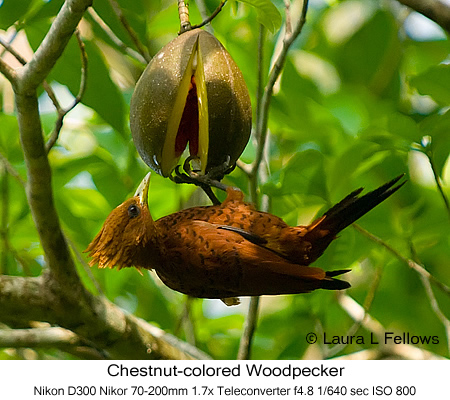
My passion for photographing forest birds comes from two primary sources. The first is that I greatly enjoy seeing the full diversity of birds on planet Earth. Perhaps three-fourths of all birds are found in structurally complex 3-dimensional environments, so restricting myself to just the birds of open places would leave me feeling like I've missed out on much that nature has to offer. Seeing and enjoying birds in a forest gives purpose to walking forest trails and greatly expands my awareness of the forested world around me. Many people are passionate birders for this very reason. As a photographer, however, I want to take my experience one step further and capture images of memorable moments and observations of the birds I see. I'm not satisfied with getting the best possible images of a select few species of birds. I want to photograph the many different kinds of birds found in the tropics because the process of photographing them helps me better experience the full diversity of life. This brings me to the second source of my passion. Making an image burns the moment into my mind, and having the image facilitates remembering the entire experience in vivid detail. To that end I constantly strive to get the best possible images, not only in terms of technical quality but also in terms of emotional impact.
The first difficulty a bird photographer faces in a tropical forest is finding subject matter. Birds are often hard to spot in a tropical forest. There is not a bird on every branch or even in every tree, and sometimes a person can walk quite a distance along a forest trail without seeing or hearing a single bird. Density and layering of foliage, movement of leaves in the breeze, shadows, myriads of bright flowers, orchids, and bromeliads, all make spotting even brightly colored birds a challenge. In addition, having a name to associate with each image is an important part of the experience, and identifying forest birds in the tropics requires some practiced skills. The aid of an expert birding guide is therefore extremely valuable for finding and identifying birds to photograph in tropical forests.
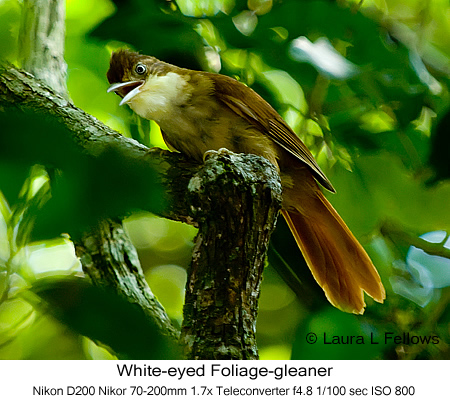
Once the birds are found within a forest, successfully photographing them requires a combination of suitable equipment, understanding the technical challenges, appropriate technique, and proper mindset. I'll address each of these in turn.
Like all photography, suitable equipment is essential to success. Bird photographers tend to believe that a 500mm super-telephoto lens with 1.7x tele-extender is a must. However, it's important to understand the trade-offs when choosing a lens. Not everyone is physically capable of carrying a heavy super-telephoto lens along forest trails. Hand-holding such a heavy lens is impractical, while using a tripod or monopod impedes photography of birds moving about in a forest. Shorter lenses such as 70-200mm or 100-400mm stabilized zoom lenses are lighter weight, easier to hand-hold and have greater light-gathering capacity. They're very suitable for photographing birds close to the photographer or at distances up to about 50m away. I use a 70-200mm Nikor VR zoom lens with 1.7x tele-extender, which is about 1/3 the weight of a super-telephoto lens, because that's the most weight I can carry. I get good results though I sometimes miss shots others can get with a longer lens.
The technical challenges for a bird photographer in tropical forests are four-fold. First, lighting conditions are highly variable and somewhat unpredictable. Determining proper exposure is problematical because lighting constantly changes depending on cloud cover above, density and layering of the forest canopy, moving shadows caused by branches swaying in the breeze, and the amount of foliage around each bird encountered. Second, reduced light inside a forest makes it harder to carry depth of field from the front of the bird to the back. Nevertheless, when a bird is surrounded by foliage, an image is more interesting to me if depth of field carries sufficiently to keep some of the nearby flowers, leaves, and branches in focus. Third, birds in complex habitats are often partially hidden from view. Obstructions in the foreground are naturally present at times, and more wary birds often deliberately hide or perch within or behind dense foliage where unobstructed views of them are infrequent. Finally, many forest birds move about constantly. As they move, obstructions periodically get in the way, lighting conditions can vary significantly, motion blur becomes a problem, and the bird's posture and orientation to the observer often change. Given these challenges, how does one get high quality images of forest birds?
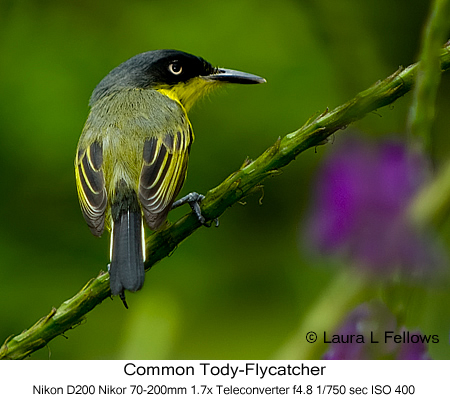
The techniques I use to photograph forest birds are driven by these challenges. I never shoot in program mode as I always want to constrain my settings. Because many birds in the forest move about frequently and somewhat unpredictably, I always use aperture priority. I prefer aperture priority over shutter priority because stopping motion blur matters more to me than depth of field. By opening up the aperture, I get the fastest possible shutter speed for the available light. The second setting I often adjust is ISO. Low ISO settings are preferable, but in forest environments where available light is often very low, I have to use a higher ISO than I would like. I typically use an ISO of 800 and try to avoid settings higher than 1000 unless I'm in very low light. In bright light I sometimes reduce my ISO as low as 200 to 400 for stationary birds, while in very low light I sometimes increase it above 1200. With newer cameras, it's even possible to set ISO as high as 6000 without losing picture quality.
Fill-flash is very beneficial when photographing forest birds. Harsh shadows are frequent within a forest, and fill flash helps fill in shadows on the subject. Fill flash also puts sparkle in the bird's eye without overpowering the ambient light. The limiting factor of fill flash is the distance it will carry. The Fresnel lens on my flash extender increases the effective distance of my flash to about 20 ft. I avoid using flash as my main light whenever possible because it results in images that look unnatural.
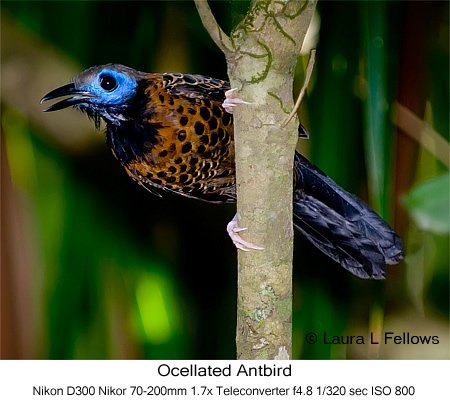
I often shoot on continuous mode. The reason is quite simple. Birds are constantly doing things even when perched in one place, and they're often doing things unpredictably and more quickly than I can react to them. By shooting in continuous mode, I'm more likely to get the shot when the bird has just the right expression, is momentarily posed in an especially pleasing way, and is in just the right light as the branches and leaves sway overhead. When shooting in continuous mode, one's memory cards need to be fast enough to keep up. Memory cards vary in data transfer rate, and if a card is too slow to keep up with the rate you're shooting pictures, corrupted images with streaking and color banding can result. You should always ensure that the number of frames per second doesn't exceed the transfer rate of your cards.
I always shoot in camera raw because raw images are much more amenable to later processing with digital darkroom software. The substantially larger size of raw images compared to compressed images along with often shooting in continuous mode means I fill up a lot of memory cards in a day. I carry 16GB of cards into the field along with an 80GB portable storage device. I download my images in the field as necessary to avoid running out of cards. My preference is to use an Epson multi-media storage viewer because it's compact, lightweight, has substantial storage capacity, and has a screen large enough to do preliminary editing and deleting of unwanted images as time permits. On extended trips I carry a second Epson and a 60GB IPod to make sure I have enough storage capacity.
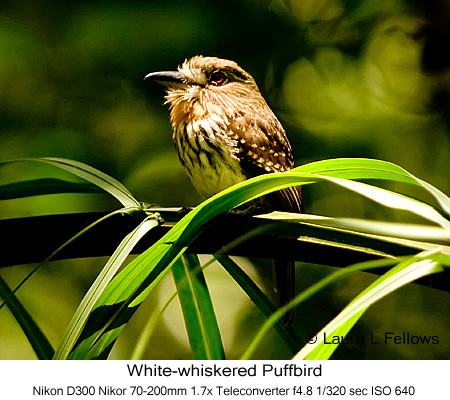
I never use bracketing in the field because I don't want my best shot taken with the wrong exposure. Instead, I frequently shoot test shots while no birds are present, aiming my camera toward canopy openings, into the mid-story, at underbrush and shadows, and in various directions all around. By checking my histograms, I get a feel for the ambient light and figure out which settings are appropriate for all the lighting conditions we're encountering at that time of day, under current weather conditions, and within that particular section of forest. As a result, I already have a very good idea what my shutter and ISO settings need to be when a bird presents itself, which makes bracketing unnecessary.
Finally, proper mindset is essential to success. One should always be ready for a bird to suddenly appear. As mentioned above, I constantly prepare for my next photo opportunity by shooting test shots whenever birds are absent. I also frequently check the amount of space I have left on the memory card in my camera. Nothing is more frustrating than discovering you've run out of space on your card while you're photographing a bird. When shooting in continuous mode, this can easily happen. Hence, I change my card out whenever I have the chance if it's more than three-fourths full. For those intent on getting great images of forest birds, there is no down time. When no birds are present, preparations for the next photo opportunity need to be underway.
Being quiet and alert while walking forest trails contributes to being successful. Forest birds are often secretive and easily disturbed, so talking on a trail increases the chances a bird will fly off instead of perching nearby where it can be photographed.
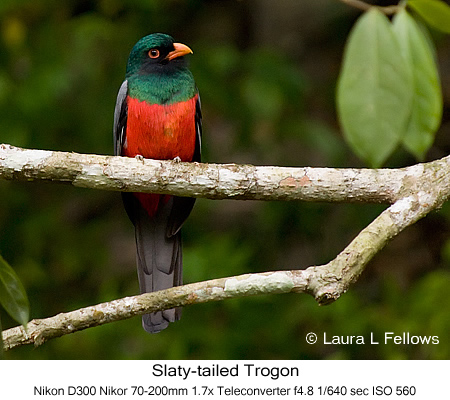
Patient photographers get images that would otherwise be missed. Birds often don't come out into the open right away. Sometimes they flit about and stay under cover until they no longer feel threatened by a person's presence. Sometimes the first images you get aren't good enough because clouds appeared overhead, foliage was in the way, or the bird was facing the wrong direction. By waiting patiently, a bird may get used to your presence, move into the open, change position, face toward you instead of away from you, and eventually pose for you. Patience can make all the difference between missing the opportunity altogether, getting a mediocre image, or getting an outstanding image.
The best photographers constantly strive to get better images. When a bird presents itself, I concentrate on that moment and try to get the best image possible no matter how many previous images I've taken of that species. Even wonderful images can be surpassed by something better, so I never pass up an opportunity just because I've photographed the bird before. My goal is to capture images that evoke feelings about each bird as a living being going about its life. What a bird looks like is just the beginning of portraying what the bird is all about. Even when you think you have a wonderful shot, a better image of the same species may be just around the next corner.



